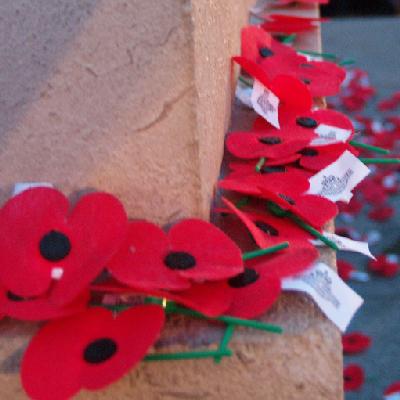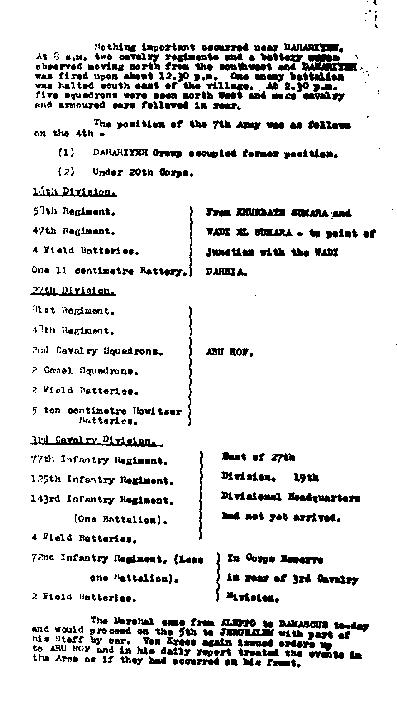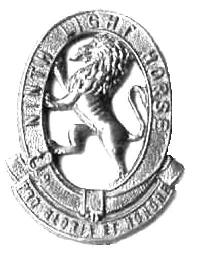The following entries are extracted and transcribed from the 9th Light Horse Regiment War Diary, the originals of which are held by the Australian War Memorial. There are 366 entries on this site. Each day has entries as they occurred from 1914 to 1919. In addition to the 9th Light Horse Regiment War Diary, when appropriate, entries from the 3rd Light Horse Brigade War Diary and other regiments with the Brigade will also appear. Entries from the unit history, Darley, TH,
r, Adelaide, Hassell Press, 1924 will also appear from time to time. The aim is to give the broadest context to the story and allow the reader to follow the day to day activities of the regiment. If a relative happened to have served in the regiment during the Great War, then this provides a general framework in which the individual story may be told.
Saturday, December 1, 19179th Light Horse Regiment Location - El Burj.
9th Light Horse Regiment War Diary - 0120, the enemy, 1,000 strong, made a determined attack on sector held by 8th Light Horse Regiment which regiment was immediately on right of 9th Light Horse Regiment. The right flank post of 8th Light Horse Regiment was forced to withdraw about 300 yards south west whilst the enemy occupied the position from which the 8th Light Horse Regiment had withdrawn. The enemy brought heavy bomb, rifle and machine gun fire to bear on 8th Light Horse Regimental posts. A Squadron 9th Light Horse Regiment, who were in position 800 yards on left front of 8th Light Horse Regiment, brought a heavy machine gun and rifle fire to bear on flank and rear of attacking force inflicting many casualties and prevented enemy retiring towards Shilta.
At dawn 0500 it was seen that the remaining enemy were in a precarious position, faced in front at a few hundred yards range by 8th Light Horse Regiment and a strong detachment of 4th Royal Scots who had hurried up in support. This detachment did fine bombing work at dawn.
About 0530 the 8th Light Horse Regiment moved forward and the remaining Turks about 100 strong surrendered including a German Lieutenant Colonel Commanding Officer of the attacking battalion. Many rifles and automatic rifles and bombs were captured from enemy. Estimated enemy dead 200 whilst 300 enemy wounded had passed previously through the Turkish dressing station. Heavy enemy shell fire continued all morning in and around El Burj. 9th Light Horse Regiment casualties four Other Ranks wounded.
3rd Light Horse Brigade War Diary -
At 0100 from the post of the 8th Light Horse Regiment on the extreme right of the Brigade sector considerable movement in its immediate front was observed and reported.
At 0110 the enemy, estimated 500 in strength, attacked the above mentioned post with hand and rifle grenades. On the 8th Light Horse Regiment calling artillery support by means of flares at 0130, the 268th Brigade, Royal Horse Artillery and the Hong Kong and Singapore Battery opened up intense artillery fire on all enemy approaches. Part of the Gloucester Yeomanry, 48 all ranks in strength under command of Palmer, Lieutenant Colonel, DSO, moved from the position at el Burj support the 8th Light Horse Regiment and at 0150 reinforced the 8th Light Horse Regiment in the fighting line where the fighting had now developed.
At 0200 the 8th Light Horse Regiment post on the right was forced to withdraw 200 to 300 yards toward the main line of defence. The enemy was now attacking heavily and pressed on toward the main line of defence, using bombs of both cricket ball and stick type, rifle grenades and automatic rifles. Their advance was covered by an enemy battery firing from Suffa, and one trench mortar bring from neighbourhood of Shilta. At this time Richardson, Lieutenant Colonel S, commanding 1/4th Royal Scots Fusiliers came to Brigade Headquarters and offered the assistance of his infantry, [who were not now under the command of the Brigade]; this offer was gladly accepted, and two companies, 130 all ranks, were sent to the support of the 8th Light Horse Regiment. An exceptionally fine feeling of comradeship had existed between the Scotch arid Australian troops but this would be the first occasion in the campaign when they had fought together.
At 0230 one of the above companies of the 1/4th Royal Scots Fusiliers reinforced the 8th Light Horse Regiment and at once operated with Mills grenades with great effect, and assisted materially in holding up the enemy attack.
At 0300 the enemy was held up within 30 yards of our main position, throughout the attack the 9th Light Horse Regiment was bringing enfilade fire with rifles machine guns, and Hotchkiss rifles, to bear on the enemy.
At 0315 the enemy appeared to be held. At this time the second company 1/4th Royal Scots Fusiliers reached 8th Light Horse Regimental Headquarters. The bombers were at once detached and immediately put into the firing line.
At 0400 the enemy fire and bombing had considerably decreased. The attack had failed.
At 0520 a large party of enemy were observed under cover in front of our positions. Their retirement had been prevented by the enfilade fire of the 9th Light Horse Regiment and the machine guns attached.
On movement towards this party by 8th Light Horse Regiment a machine gun and Hotchkiss Rifle barrage was put down by 9th Light Horse Regiment from a position on the left front. Our two batteries put down a barrage behind the enemy also. This party surrendered and 105 unwounded prisoners were captured and with them being the Commanding Officer of the Battalion.
Our total casualties were 56, of which 39 were in the 8th Light Horse Regiment. Seventeen wounded Turkish prisoners were brought in during the day.
A captured Medical Officer stated that the attacking forces consisted of an assault battalion of the 19th Division and that exclusive of the wounded that had been evacuated by him early in the fight, there was none of the Battalion left. A few days later, three men, who said they belonged to this battalion, came in and surrendered saying that their comrades were either killed or with us as prisoners and that they were lonely and wanted to join the latter.
This assault battalion consisted of specially picked troops; their physique was the best we had ever seen amongst Turkish prisoners. The battalion had only arrived a few days before from the Galician front. They were all armed with bombs and most of them wore German type of steel helmet. One man had thrown 92 bombs [as was evident by the number of metal clips], before he was shot through the head.
Included in the captured material were eight automatic rifles, similar in pattern to our own Hotchkiss Rifles.
For service in this action the following decorations were awarded: - MacPherson, Captain LAW; and, Peppercorn, Lieutenant TR, Military Crosses. Carrington, 353 Staff Sergeant Major AH; and, Keeble, 1010 Trooper HW, DCMs.
At 0600, 1st December, the original line held by the Brigade, was reoccupied. The situation became quiet with intermittent enemy shelling and machine gunning.
Congratulations on the good fight put up were received from the 20th Corps and Desert Mounted Corps Commanders during the day. Parties burying, own and enemy dead were kept busy throughout the day. Enemy dead in front of our position had to remain unburied for several days. On attempting to reach the bodies, our troops came under very heavy enemy machine gun and rifle fire.
At 1700 on 1st December, 1/4th Royal Scots Fusiliers moved from the 3rd Light Horse Brigade area at El Burj, and marched to Latron. Cheers were exchanged between the Scotchmen and the Australians as the former moved off. One Scott was heard by his Commanding Officer to say to another - "Those are the sort of men I like to support, you will find them in the firing line when you get up there to support them - you won't have to bring them back with you."
The disposition of the Brigade remained - 8th Light Horse Regiment holding right sector, 9th Light Horse Regiment left sector, and Gloucester Yeomanry in support 400 yards north of El Burj. A state of trench warfare now existed, but in place of trenches, stone sangars were erected. The Turks occupied Shilta - Balin and Suffa, but gradually fell back on to the line Kuddis - Kurbeth Ibn Harith - Kefr Namah. Until 27th December, Australian Mounted Division held the sector of the line opposite these places, gradually pushing the line forward and consolidating. Two of the 3rd, 4th and 5th Brigades were relieved in turns for a few days from the line by the third one during' this period. The Headquarters of the 3rd Light Horse Brigade were established at several different places in the area. Heavy rains fell and much discomfort and cold were experienced by all ranks. Life in the rocky and high hills was now the extreme of that spent for so long in the sands of the Sinai desert. Supplies were received regularly but often there was an unavoidable short issue. Supply columns between rail head and Latron often failed to get through on account of the boggy nature of the only available tracks. The enemy showed very little activity; close observation was being kept.
The enemy's positions at Kefr Namah - Kurbeth Ibn Harith - Jurdeh and Kuddis were daily shelled by our artillery. Any appearance of enemy in his defence works would immediately be followed by the opening of our guns on to him, and he now always aimed for concealment. Any additional work to his defences was carried out during the night. The situation all along the Divisional line became exceptionally quiet, only an occasional machine gun burst could be heard. Sniping and rifle fire had practically ceased.
Although wet and wintry conditions prevailed, all ranks were gradually bivouacking under more comfort. Many were forced to remain wet for several days, but all were now becoming more or less used to these conditions. Strong defences, [chiefly sangars], were built all along the line. Enemy aeroplanes became active and two or three times daily flew over our lines, sometimes at a low altitude.
8th Light Horse Regiment War Diary - Line was all quiet until 0030 on 1 December 1917 when Captain Walker, MC, "B" Squadron, reported enemy concentration on his immediate front. Brigade Headquarters were wired immediately, priority, for reinforcements.
The enemy attacked about 250 strong with many bombs at 0045 and after half an hour's heavy fighting at very close quarters, "B" Squadron were compelled to fall back to (Major Crawford's) "C" Squadron's position. Here a fresh line was made, every available man being in the firing line.
48 men of the Gloucester Yeomanry, under Lieutenant Colonel Palmer, arrived at 0200 and the enemy just then made a fresh assault. One company of the 4th Royal Scottish Fusiliers under Captain Henry arrived at 0230 and all were immediately sent into the line.
The enemy made two distinct rushes with about 500 men, and were each time held off with a very heavy close range fire.
The fighting gradually diminished and the enemy position was rendered absolutely safe by the arrival at 0430 of another Royal Scottish Fusiliers company who were kept in supports. "B" Squadron took possession of their original position and touch was again made with 4th Light Horse Brigade on right flank.
Throughout the hours of fighting there was much heavy bombing, especially on the part of the enemy who were evidently well supplied. Our Mills Grenades were very superior and effective. The 9th Light Horse Regiment had managed to get a rearguard machine gun fire and this partly had the effect of cutting the enemy off from Shilta Village.
At daybreak the survivors surrendered amounting approximately to:-
6 Officers (including the Battalion Commander), and 112 Other Ranks, and about 20 wounded.
The enemy dead amounted to approximately 100. (20 on "B" Squadron's ridge and 80 on "C" Squadron's ridge.)
The Royal Scottish Fusiliers and Yeomanry did splendid work and had it not been for their very quick arrival after the alarm, the Regiment would have received a very severe handling.
Our casualties were (approximately) 2 Officers - Captain Fay and Lieutenant SK Moore killed and 5 Other Ranks and 2 Officers and 35 Other Ranks wounded (one of them since died). All ranks displayed great intrepidity and dash throughout.
Major General Hodgson visited the Regiment next morning and personally expressed his pleasure and congratulations. The two attached telegrams are copies of those received from Desert Corps and 20th Army Corps.
During the morning the Royal Scottish Fusiliers were withdrawn and the Regiment continued to hold the line with the Gloucester Yeomanry in supports. Much booty was collected throughout the day included in which were 8 new type automatic rifles.
The 6th Nottinghamshire Battalion (2 Companies) reported to Regimental Headquarters as reserves at 2030 and retired at 0500 on 2 December 1917.
During the day a wire was received containing the following awards:
405 Lance Corporal J Kerr, Military Medal
1176 Trooper ES Ackland, Military Medal
3103 Trooper L Taylor, Military Medal
Regiment held firing line as taken over on night of 30 November / 1 December, with Gloucester Yeomanry in supports. At 0230, 1 Company South Nottinghamshires reported at Reserve Troops and remained in vicinity of Regimental Headquarters until 0500, 2 December 1917.
10th Light Horse Regiment War Diary - Reference map 1\63360, Palestine map Sheet XVII.
On 1st December the 10th Light Horse Regiment continued reconnoitring, most of which had to be done on foot, it was impossible to get horses over the country. Reconnaissance to Erras disclosed abundant supply of water at that place and at 0600 one squadron, 10th Light Horse Regiment moved from Artuf to establish itself at Erras, and carry out reconnaissance to Bittir - Welejeh - Khudr - Hausan and towards Beit Jala and the Hebron Road. Natives were very friendly towards our troops and much information of the enemy was gained.
See: El Burj








